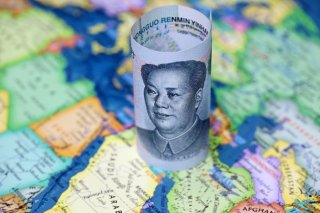China Has a Clear Middle East Strategy. Does America?
Just as China perceives economic and security ties as building blocks toward an overarching security architecture, the United States must follow suit.
The United States’ foreign policy toward the Middle East is a contradictory one. The United States maintains a system of strategic partnerships aimed at countering mutual threats and maintains a robust naval presence in the region that not only protects trade routes vital to the U.S. and global economy but routinely holds multi-partner exercises. At the same time, the United States seeks to pivot towards the Indo-Pacific.
This has created a void that China seeks to fill by using its non-alliance policy with regional partners that are U.S. allies and foes alike. Initially, China fosters pragmatic economic ties with nations on a purely transactional basis to achieve security via development. This was epitomized by the China-Arab States Cooperation Forum’s Ambassador Li Chengwen, who in 2016 declared, “The root problems in the Middle East lie in development and the only solution is also development.” As these economic bonds deepen, China will seek to cement them with security ties that inevitably contradict U.S. interests.
China’s attempts to displace the United States in the Middle East are likely to attract the latter’s long-term assets back into the region. In a testimony to the Senate Armed Services Committee, Gen. Michael Erik Kurilla, commander of U.S. Central Command, asserted in March 2023 that the United States was “in a race to integrate with our partners before China can fully penetrate the region.” Thus, trade ties or the tech race cannot be treated in a siloed manner and distinct from broader security concerns due to the direct spill-over from technology to security. Noting the organic nature of China’s economic, political, and strategic concerns, Kurilla declared, “The People’s Republic of China has chosen to compete in the region. The PRC is aggressively expanding its diplomatic, informational, military and economic outreach across the region.”
China perceives development and trade as synonymous. In turn, China’s Belt Road Initiative (BRI) is committed to investing in both physical and digital infrastructure that includes connecting ports and facilities and adopting e-government platforms. By expanding Gulf digital sectors with advanced technologies, Huawei and Alibaba are actively contributing to the Gulf’s digital transformation that underpins the Digital Silk Road. The U.S. response has been to conduct a “clean network” campaign that dissuaded third countries from buying Huawei and ZTE 5G equipment. Furthermore, in July 2022, President Joe Biden signed a 5G and 6G memorandum of cooperation with Saudi Arabia. Yet, this is only a start, as China is Saudi Arabia’s largest trading partner and Riyadh is seeking to invest $50 billion into China. The United States must explore the range of next-generation technologies to serve as a counterweight to China’s Digital Silk Road. This would prevent Chinese telecommunications and information technology from posing a security threat to U.S. forces and allies operating in the region.
In the absence of advanced U.S. technologies, China’s BRI is aligned with Saudi Arabia’s Vision 2030 which is committed to developing trade and technical hubs, manufacturing and logistics facilities, artificial intelligence, digital industries, and smart-city infrastructure. Saudi Arabia is diversifying its economy to attract foreign investments and enable it to be a central node that connects continents. This positions the Saudi kingdom as the BRI’s crown jewel due to its critical location on a pathway that allows China to access Europe and Africa via Iran, the United Arab Emirates, Egypt, and Algeria. This serves as the foundation for China to seek to establish comprehensive strategic partnerships with the Middle East.
China’s involvement in the region has evolved from being purely economic to engaging on regional political and security issues. In December 2021, it was reported that China was assisting Saudi Arabia with its ballistic missile program and manufacturing its own armed drones. China sought to build a military base in Abu Dhabi as well, but the venture was abandoned due to U.S. pressure. The risk exists that as China continues to deepen its economic and strategic ties, it may be in the position to advance its security interests to the extent that U.S. allies are less likely to succumb to U.S. pressure. This is due to U.S. inconsistency in its application of pressure and being perceived as non-committal toward the region’s security. According to one Iranian official, China oversaw the formation of a regional naval coalition that includes Iran, Saudi Arabia, the UAE, and others to reinforce maritime navigation and the security of shipping lanes, which directly confronts the mission of U.S. CENTCOM.
Yet China’s strategy of establishing economic ties as the foundation for security ties while maintaining a policy of non-alignment is unsustainable. It is not possible for China to advance its nuclear cooperation with Saudi Arabia and the UAE without raising the ire of the Iranian regime.
U.S. strategic partners across the region will continue to mirror the behavior of the United States. If the United States is perceived as strategically engaged in the region and willing to shore up the defenses of Gulf Cooperation Council states with advanced technologies to counter China’s Digital Silk Road, they are unlikely to hedge and orientate themselves toward Chinese naval and security coalitions. This is inextricably tied to the United States’ bid to prevent China from embedding itself in the region’s infrastructure and investing in advanced technologies such as clean energy that could be incorporated into Gulf economic diversification efforts. Just as China perceives economic and security ties as building blocks toward an overarching security architecture, the United States must follow suit.
Harley Lippman is a board member of the United States Agency for International Development's (USAID) Partnership for Peace Fund.
Image: Shutterstock.

